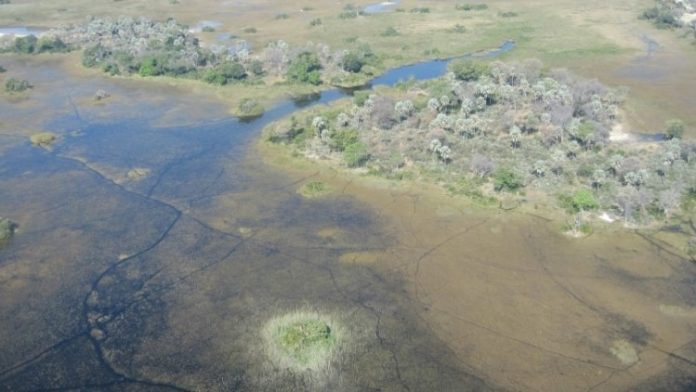Our Terms & Conditions | Our Privacy Policy
New Report Urges Scaling Nature-Based Solutions to Combat Africa’s Climate Crisis
 Okawango Delta.
Okawango Delta.
Teo Gómez, Wikimedia Commons
A landmark report by the World Resources Institute (WRI) and the World Bank, backed by the African Development Bank (AfDB), reveals a surge in nature-based climate projects across Sub-Saharan Africa, offering a lifeline for a region battered by worsening floods, droughts, and heatwaves.
Titled Growing Resilience: Unlocking the Potential of Nature-Based Solutions for Climate Resilience in Sub-Saharan Africa, the study analyzes nearly 300 initiatives over the past decade, underscoring their potential to mitigate disasters while creating jobs, protecting biodiversity, and advancing social equity.
Between 2012 and 2021, the number of nature-based solution (NBS) projects in the region grew by 15% annually, with funding increasing 23% yearly to surpass $12 billion. These efforts—ranging from reforesting degraded watersheds to restoring urban wetlands—often blend natural systems with conventional infrastructure, such as pairing mangrove restoration with seawalls to buffer coastal communities from storms. Despite progress, financing remains woefully inadequate compared to Africa’s estimated $100 billion annual infrastructure gap, leaving millions exposed to climate shocks.
“Africa’s vulnerability is a global wake-up call,” said Qimiao Fan, World Bank Country Director for Kenya, Rwanda, Somalia, and Uganda. “Nature-based solutions aren’t optional add-ons—they’re essential to safeguarding lives and livelihoods, particularly for marginalized groups.” The report arrives as extreme weather pummels the continent, from Kenya’s catastrophic floods to record-breaking heatwaves in the Sahel, underscoring the urgency of scaling resilience measures.
Cities: The Overlooked Frontier
While NBS projects have gained traction in rural areas, the report identifies a critical blind spot: urban centers. Seventy percent of Africa’s cities face severe climate risks, including lethal heat islands and flash floods exacerbated by sprawling informal settlements and inadequate drainage. Yet only a fraction of NBS investments target these areas. To bridge this gap, WRI announced the launch of the *Green-Gray Infrastructure Accelerator*, a initiative supporting 11 African cities to integrate natural systems like urban forests and floodplain restoration with traditional infrastructure like storm drains.
“Infrastructure isn’t just concrete and steel—it’s the mangroves that shield coasts and the wetlands that filter water,” said Ani Dasgupta, WRI President and CEO. “Blending green and gray solutions can save costs, boost resilience, and create healthier cities.” Pilot projects in Freetown, Sierra Leone, where tree-planting campaigns reduced landslide risks, and in Kampala, Uganda, where wetland restoration curbed flooding, highlight this dual approach’s potential.
Barriers and Blueprints
The report outlines systemic hurdles slowing NBS adoption, including fragmented policies, limited technical expertise, and reliance on short-term grants rather than sustainable financing models. To scale impact, authors urge governments to embed nature-based strategies into national climate plans, diversify funding through green bonds and public-private partnerships, and prioritize projects offering multiple co-benefits, such as Kenya’s Northern Rangelands Trust, which combats desertification while supporting pastoralist communities.
International development banks are gradually shifting focus. The AfDB, for instance, recently backed urban green corridors in Abidjan to counter heatwaves, while the World Bank funded Zambia’s Kafue River Basin restoration to safeguard water supplies for 2 million people. However, critics stress that without increased local capacity and equitable community engagement, even well-funded projects risk faltering.
As global temperatures rise, Africa’s experiments with nature-based solutions offer lessons for the world. Yet success hinges on rewriting the financing playbook—diverting subsidies from fossil fuels and carbon-heavy infrastructure toward systems that heal, rather than harm, the planet. The $12 billion invested in NBS over a decade is a start, but matching rhetoric with resources will determine whether these green innovations become lifelines or luxuries.
The report was produced by WRI’s Cities4Forests initiative and the World Bank’s Global Facility for Disaster Reduction and Recovery, with support from the AfDB, Green Growth Knowledge Partnership, and funding from SIDA, MAVA Foundation, GIZ, BMZ, and DANIDA.
Send your news stories to newsghana101@gmail.com
Follow News Ghana on Google News
[ad_1]
Images are for reference only.Images and contents gathered automatic from google or 3rd party sources.All rights on the images and contents are with their legal original owners.
[ad_2]


Comments are closed.